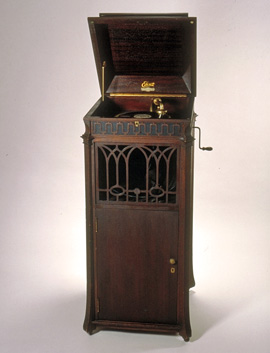Edison Official Laboratory Model C-19 “Chippendale”
1919, U.S.A.
Thomas Edison is credited with the invention of the cylinder phonograph, which used a copper cylinder wrapped in tinfoil to record and reproduce sound. Chichester Bell and other inventors followed Edison and made various improvements to the phonograph: They developed better sound quality by waxing a thick strip of cylindrical paper to create the phonograph record. In 1887, the German-born American inventor Emile Berliner introduced a spiral grove on a flat rotating disc. He called his invention the gramophone.
This Edison Official Laboratory Model C-19 “Chippendale” was manufactured as the most luxurious model of gramophone designed for use with longitudinal vibration disc records. To demonstrate its quality, Edison once substituted a recording played on this gramophone for a human opera singer in the middle of a live performance, yet the audience, it is said, did not realize the sound had been switched from a real human voice to the gramophone’s performance.


